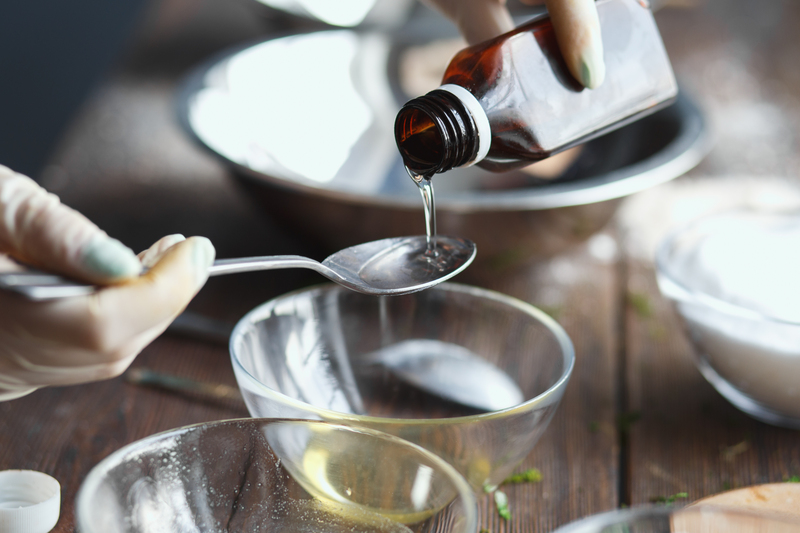Discover Effective Ways to Remove Mould from Window Sills
Posted on 31/05/2025
Discover Effective Ways to Remove Mould from Window Sills
Mould growth on window sills is a common nuisance in homes, especially in areas with high humidity or poor ventilation. These unsightly patches not only mar the beauty of your interiors but also pose significant health risks. Breathing in mould spores can lead to allergies, respiratory issues, and exacerbate asthma symptoms. For these reasons, it's crucial to learn effective methods to remove mould from window sills and to keep your living spaces fresh and safe.

Why Does Mould Grow on Window Sills?
Before tackling the issue, understanding why mould develops on window sills is important. Here are some common causes:
- Condensation: Moist air condenses on cool glass and frames, creating a damp environment perfect for mould spores.
- Poor Ventilation: Limited airflow fails to evaporate moisture, allowing mould to thrive.
- Leaky Windows: Faulty sealants or frames let rainwater seep in, providing further moisture.
- Dust and Organic Matter: Dust on sills serves as a food source for mould.
Recognising Different Types of Mould on Window Sills
Moulds come in various forms and colours. Identifying the type of mould can help you choose the right cleaning method. The most common types found on window sills include:
- Black mould (Stachybotrys chartarum): Often toxic, appears as sticky black spots.
- Green mould: Usually less toxic but still hazardous.
- White mould: Looks chalky and spreads quickly.
- Grey mould: Sometimes mistaken for dust or dirt.
Preparation: What You'll Need to Remove Mould Effectively
Before starting the cleaning process, ensure you have the proper supplies to remove window sill mould safely:
- Protective gloves
- Face mask or respirator
- Eye protection (goggles recommended)
- Old clothes (mould can stain fabric)
- Spray bottle
- White vinegar or hydrogen peroxide
- Baking soda
- Mild detergent or soap
- Scrubbing brush and sponges
- Microfibre cloths
- Optional: Commercial anti-mould cleaner
- Bucket of warm water
Simple Home Remedies to Clean Mould from Window Sills
Home remedies are cost-effective, eco-friendly, and usually safe for most surfaces. Here are some of the best methods you should consider:
The Power of White Vinegar
White vinegar is a natural antifungal agent, effective at killing up to 82% of mould species. To use this solution:
- Pour undiluted vinegar into a spray bottle.
- Spray generously onto the affected window sill area.
- Let it sit for an hour to penetrate mould spores.
- Scrub firmly with a brush or sponge.
- Wipe with a damp cloth and allow the area to air dry completely.
Baking Soda Solution
Baking soda is an effective, non-toxic cleaning agent. Here's how to use it:
- Mix one teaspoon of baking soda with two cups of water.
- Spray the area and scrub away the mould.
- Wipe off any residue with a damp cloth.
- Respray with baking soda and let air dry for extra protection.
Hydrogen Peroxide for Stubborn Mould
Hydrogen peroxide is a strong antifungal and antiviral cleaner. Use 3% hydrogen peroxide as follows:
- Spray directly onto the mould-infected area.
- Allow it to fizz and bubble for 10-15 minutes.
- Scrub thoroughly and wipe dry.
Lemon Juice for a Fresh Scent
If you prefer a natural scent, try lemon juice:
- Apply fresh lemon juice generously to the mould growth.
- Leave for 10 minutes, then scrub and wipe clean.
Mixing Cleaning Methods
Sometimes, a combination gives the most effective results. For tough, persistent mould, you can combine vinegar and baking soda, or use a commercial anti-mould spray after a natural cleaning routine.
Step-by-Step Guide to Remove Mould from Window Sills
-
Prepare your area:
- Wear gloves, mask, and goggles to protect your skin and respiratory system.
- Clear the windowsill; remove blinds, curtains, and nearby items.
- Lay down old newspapers or towels to catch drips.
- Vacuum loose mould spores (optional): Using a vacuum with a HEPA filter gently remove visible mould or debris. Dispose of the vacuum bag immediately.
- Spray your chosen cleaning solution: Thoroughly cover the affected area.
- Wait for 10-60 minutes: Allow the solution to break down the mould.
- Scrub gently: Use a scrubbing brush or sponge. For hard spots, repeat spraying and scrubbing.
- Wipe clean: Use a damp microfibre cloth to remove residue.
- Dry completely: Mould will return if moisture remains, so open windows or use a fan until the sill is bone dry.
- Dispose of cleaning materials: Throw away used cloths or wash them with hot water immediately.
Commercial Products to Remove Mould from Window Sills
While home remedies are effective, sometimes you need specialist mould removers. Choose commercial mould removal sprays specifically labelled for indoor use.
Popular anti-mould products include:
- HG Mould Spray
- Cillit Bang Black Mould Remover
- Dettol Mould & Mildew Remover
- Everbuild Mould Spray
When to Seek Professional Help
If mould covers an area larger than 1 square metre, is deeply embedded in wood or plaster, or comes back rapidly after cleaning, you may need to hire a professional mould remediation expert. They have powerful biocides, protective gear, and can check for underlying issues causing the mould.
How to Prevent Mould Returning on Window Sills
The key to long-term mould control is ongoing prevention. Here's what you should do:
- Improve ventilation: Regularly open windows and use extractor fans in bathrooms and kitchens.
- Use a dehumidifier: Keep humidity below 60% to deter mould growth.
- Fix window leaks: Repair seals, frames and flashing to prevent water ingress.
- Clean window sills weekly: Wipe away dust and condensation.
- Install double glazing: This reduces condensation on colder surfaces.
- Apply an anti-mould paint or sealant: Treat wooden or painted window sills with products that resist moisture and mould.
- Avoid drying clothes indoors: Unless using a vented tumble dryer, as this raises humidity.
- Move furniture away from windows: Improve air circulation near window sills.

Frequently Asked Questions About Mould Removal from Window Sills
Is bleach an effective way to remove mould from window sills?
Bleach can kill surface mould, but it does not penetrate porous materials like wood or plaster. It may also discolour paint or window frames. For organic surfaces, use vinegar, hydrogen peroxide, or a specialist product.
Can I prevent mould naturally?
Yes! Regularly cleaning with white vinegar or baking soda acts as a natural barrier. Keeping your home dry and well-ventilated is the best natural prevention method.
Is window sill mould dangerous?
Small patches are usually manageable, but any sign of black mould or extensive contamination should be treated with caution. Prolonged exposure, especially for people with allergies or asthma, can cause health issues.
Does repainting stop mould?
Repainting alone does not solve the problem unless you eliminate the source of moisture. Use anti-mould paint products and address leaks before repainting.
What's the fastest way to clean mould off window sills?
Use a commercial mould remover for fast results. For a natural approach, vinegar or hydrogen peroxide are quick and effective. Always dry the sill thoroughly afterward.
Keep Your Home Healthy by Removing and Preventing Window Sill Mould
Mould on window sills is more than just an eyesore--it can affect your health and compromise your home's integrity. Fortunately, understanding how to remove mould from window sills and prevent its return is easy with the right approach. Follow the steps outlined in this guide for a cleaner, healthier home.
Make regular mould checks part of your household cleaning routine and invest in strategies to reduce indoor moisture. With these effective window sill mould removal tips, you'll keep your windows sparkling and your family protected.
Looking for more home cleaning advice?
Bookmark this guide, and check our other deep-cleaning articles for more expert tips on household maintenance and hygiene!



